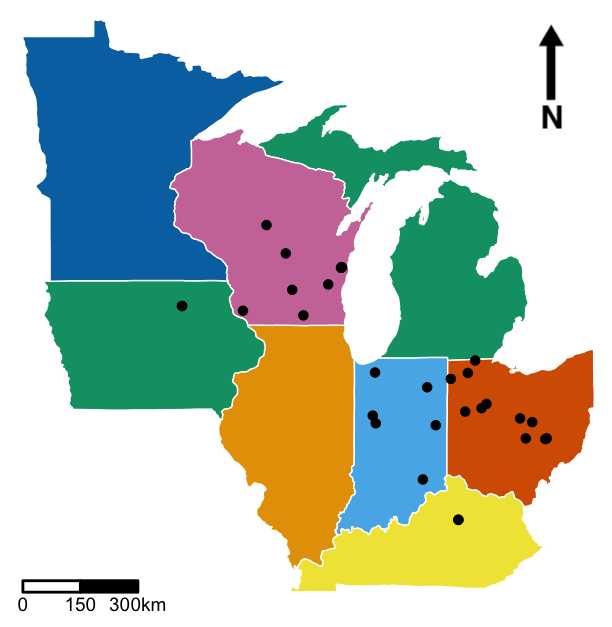By Steven Culman, Associate Professor and State Specialist in Soil Fertility
Most farmers value soil health in theory, but few studies have worked to place an actual agronomic value on soil health. A study published earlier this spring found that a 10% improvement in certain soil health measurements increased relative yields by an average of 5% across N fertilizer rates. In other words, good soil health means getting more bang for every buck spent on fertilizer.

FIGURE 1. Map of sites in the study.
Study leader, former Ohio State PhD student Dr. Jordon Wade, based these findings on analysis of corn nitrogen (N) rate trials throughout the Midwest. His findings were consistent across a variety of soils and climatic conditions across the Corn Belt (Fig 1).
Improving N use efficiency is linked to soil biology and the cycling of organic matter, both of which are important components of soil health. In response to increased attention on soil health, both commercial and university research labs have begun offering soil health testing services. These tests often focus on the biological activity of the soil, specifically targeting the portion of soil organic matter thought to be active during the growing season. However, there are few guidelines for applying test results to fertility recommendations.
What Soil Health Tests Should I Use?
In this study, researchers used three different measurements of active organic matter: permanganate oxidizable carbon (POXC) soil protein, and respiration (Solvita). They also included total organic matter content, which is often included in a standard soil test.
The research team found that respiration test was much less useful in making N recommendations than the other three tests. Instead, respiration seemed to reflect inherent soil characteristics more than management-related changes. Based on this study, Wade recommends POXC and soil protein, as well as a standard organic matter soil test. Together, these 3 tests provide insight into how management is affecting your N efficiency.
How Can I Find and Use These Tests?
As with many emerging soil health tests, availability is limited. However, here in Ohio, the Soil Fertility Lab started offering these measurements through eFields in 2020 as part of on-farm research projects. You can find more information by contacting Steve Culman (info below) or your local OSU Extension County Educator.
At this time, interpretation of results is simplistic: if your POXC, soil protein, and organic matter levels are going up, you will have increasing N use efficiency. POXC values are generally quicker to respond than soil protein or organic matter, so you may need to wait at least one full rotation of corn and soybeans to see if you are headed in the right direction. In the future, the study authors hope to use these measurements to give more precise recommendations.
For reliable results, be sure to use consistent sampling techniques from one year to the next. Take your soil samples at a similar time of year and use the same lab for analysis. For more information on effective soil sampling, visit soilhealth.osu.edu.
The study was published in the journal Scientific Reports and is available via public access. For any questions or more information, contact Dr. Jordon Wade (jordonwade@gmail.com) or Dr. Steve Culman (culman.2@osu.edu).







Post a comment
Report Abusive Comment